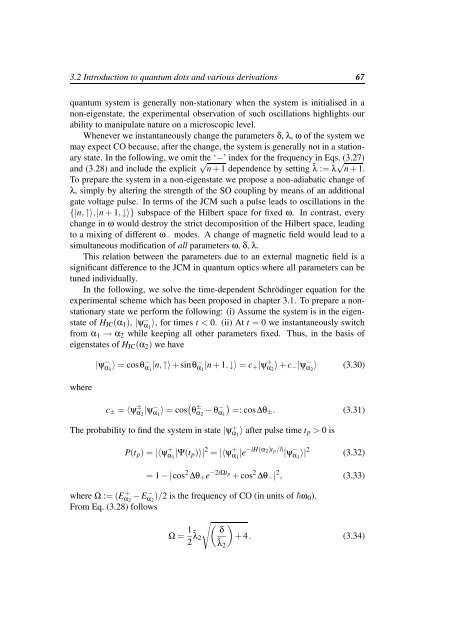Spin-orbit coupling and electron-phonon scattering - Fachbereich ...
Spin-orbit coupling and electron-phonon scattering - Fachbereich ...
Spin-orbit coupling and electron-phonon scattering - Fachbereich ...
Create successful ePaper yourself
Turn your PDF publications into a flip-book with our unique Google optimized e-Paper software.
3.2 Introduction to quantum dots <strong>and</strong> various derivations 67<br />
quantum system is generally non-stationary when the system is initialised in a<br />
non-eigenstate, the experimental observation of such oscillations highlights our<br />
ability to manipulate nature on a microscopic level.<br />
Whenever we instantaneously change the parameters δ, λ, ω of the system we<br />
may expect CO because, after the change, the system is generally not in a stationary<br />
state. In the following, we omit the ‘−’ index for the frequency in Eqs. (3.27)<br />
<strong>and</strong> (3.28) <strong>and</strong> include the explicit √ n + 1 dependence by setting ˜λ := λ √ n + 1.<br />
To prepare the system in a non-eigenstate we propose a non-adiabatic change of<br />
λ, simply by altering the strength of the SO <strong>coupling</strong> by means of an additional<br />
gate voltage pulse. In terms of the JCM such a pulse leads to oscillations in the<br />
{|n,↑〉,|n + 1,↓〉} subspace of the Hilbert space for fixed ω. In contrast, every<br />
change in ω would destroy the strict decomposition of the Hilbert space, leading<br />
to a mixing of different ω − modes. A change of magnetic field would lead to a<br />
simultaneous modification of all parameters ω, δ, λ.<br />
This relation between the parameters due to an external magnetic field is a<br />
significant difference to the JCM in quantum optics where all parameters can be<br />
tuned individually.<br />
In the following, we solve the time-dependent Schrödinger equation for the<br />
experimental scheme which has been proposed in chapter 3.1. To prepare a nonstationary<br />
state we perform the following: (i) Assume the system is in the eigenstate<br />
of H JC (α 1 ), |ψ − α 1<br />
〉, for times t < 0. (ii) At t = 0 we instantaneously switch<br />
from α 1 → α 2 while keeping all other parameters fixed. Thus, in the basis of<br />
eigenstates of H JC (α 2 ) we have<br />
where<br />
|ψ − α 1<br />
〉 = cosθ − α 1<br />
|n,↑〉 + sinθ − α 1<br />
|n + 1,↓〉 = c + |ψ + α 2<br />
〉 + c − |ψ − α 2<br />
〉 (3.30)<br />
c ± = 〈ψ ± α 2<br />
|ψ − α 1<br />
〉 = cos ( θ ± α 2<br />
− θ − α 1<br />
)<br />
=: cos∆θ± . (3.31)<br />
The probability to find the system in state |ψ + α 1<br />
〉 after pulse time t p > 0 is<br />
P(t p ) = |〈ψ + α 1<br />
|Ψ(t p )〉| 2 = |〈ψ + α 1<br />
|e −iH(α 2)t p / |ψ − α 1<br />
〉| 2 (3.32)<br />
= 1 − |cos 2 ∆θ + e −2iΩt p<br />
+ cos 2 ∆θ − | 2 , (3.33)<br />
where Ω := (E + α 2<br />
− E − α 2<br />
)/2 is the frequency of CO (in units of ω 0 ).<br />
From Eq. (3.28) follows<br />
Ω = 1 2 ˜λ 2<br />
√ ( δ<br />
˜λ 2<br />
)<br />
+ 4. (3.34)
















